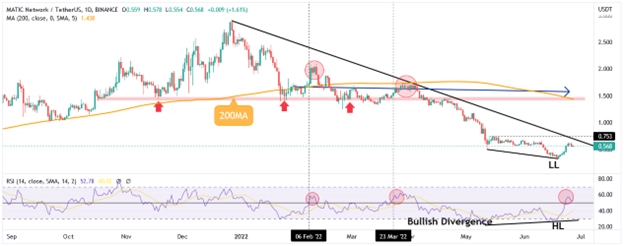Polygon’s RSI Hints at Bullish Divergence
Polygon (MATIC) has printed a bullish divergence signal on the daily chart, which helped the cryptocurrency appreciate by 65%. The RSI bullish divergence is a classic signal that hints at a possible change in the MATIC price from bearish to bullish.
Throughout this analysis, we're going to examine whether the current rally has more legs to the upside or this is just a short-lived rally.

RSI Bullish Divergence
The Relative Strength Index (RSI) bullish divergence forms when the MATIC price makes lower lows while at the same time the momentum oscillator makes a higher low.
This is often considered a buy signal. However, the overall price structure still looks bearish. From a technical point of view, two things are working against the bulls:
The price is still trading well below the 200-day Simple Moving Average (SMA), which hints at a bearish trend.
MATIC's price still trades below the descending trendline drawn from the previous all-time high.
While the RSI broke above the 50 mid-level the previous two times, it displayed the same pattern; MATIC's price reversed back down as the bullish momentum dried out.
What is a RSI Bullish Divergence?
A bullish divergence is a technical pattern in which the price of an asset makes lower lows, while the momentum oscillator makes a higher low.
The RSI bullish divergence usually forms at the end of a downtrend. The more consecutive lower lows the price makes, the more bullish the divergence becomes.
The bullish divergence is considered a strong reversal pattern, as it shows that the selling pressure has dried out and the bulls are starting to gain control over the market.
200-Day Moving Average
When the 200-day Simple Moving Average turns flat, that is often a sign of more consolidation ahead. Some key levels to consider for a possible range action are the $0.75 short-term resistance level and the previous swing low of $0.31.
Looking forward
The RSI bullish divergence hinted at a possible change in trend for the MATIC price. However, the bearish price structure still dominates the longer-term outlook.
If the price were to break above the descending trendline and reclaim the 200-day simple moving average, that would be considered a strong bullish sign.

